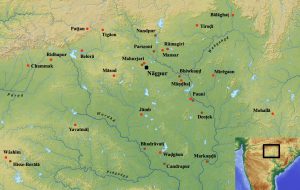
Ancient Vidarbha showing find-spots of Vākāṭaka inscriptions. (Zenodo).
| Metadata | |
|---|---|
| Object ID | OB00159 |
| Title | Balaghat Single Plate of Pravarasena II |
| Subtitle | |
| Inscription(s) | IN00172 |
| Child Object | |
| Parent Object | |
| Related Objects | |
| Responsibility | |
| Author | |
| Metadata recorded by | Dániel Balogh |
| Authority for metadata | |
| Metadata improved by | Dániel Balogh |
| Authoriy for improved | |
| Description | |
| Material | Metal / copper alloy |
| Object Type | Plate |
| Dimensions: | |
| Width | 19 |
| Height | 10.7 |
| Depth | 0.25 |
| Weight | 350 |
| Details | A single plate (probably the third of an original set of four or five), inscribed on both faces. All other components of the set are lost. The shorter edges bulge, so the longer dimension is 19 cm in the centre, but only 18.4 cm at the edges. The plate has no rims. The hole (0.9 cm in diameter) for the connecting ring is on the left-hand side, vertically at the centre, and perhaps about 2.5 cm from the edge (Mirashi reports the hole as being 1" from the centre, which is clearly not the case). |
| History | |
| Created: | |
| Date | |
| Place | |
| Other ancient history | |
| Found: | |
| Date | around 1919 |
| Place | Balāghāṭ |
| Other modern history | |
| Latest: | |
| Date | 1963 |
| Place | Patna Museum |
| Authority | Mirashi, Vasudev Vishnu. (1963). Inscriptions of the Vākāṭakas (Corpus Inscriptionum Indicarum 5). Ootacamund: Archaeological Survey of India. |
| Details | Found "somewhere in the Central Provinces" according to Altekar 1928, and in Jabalpur according to Jayaswal 1933: 74. Mirashi 1963: 69 says Hira Lal believed that this plate belonged to a set discovered in Mānsar near Rāmṭek, divided among the miners who found them and lost to scholarship. This was apparently Hira Lal's personal communication, as Mirashi only cites Hira Lal 1916: 5 for this, which is a description of the Mānsar plate (OB00160). Mirashi 1936: 49-50 and Mirashi 1963: 69-70 convincingly argues against this hypothesis and reports that his inquiries indicate that the plate was discovered around 1919 while digging a house foundation in Balāghāṭ (21.812799, 80.18457), near where he also identifies several localities mentioned in the plate. Eventually it was deposited in Paṭnā museum (which Mirashi consistently spells Pāṭnā, but in all probability this is the capital of Bihar, not a different town). |
| Notes | |